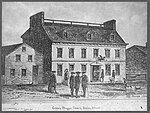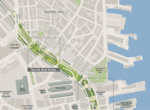Haymarket in Boston is an open-air market on Blackstone, Hanover, and North Streets, next to the Rose Fitzgerald Kennedy Greenway between the North End and Government Center.
The market is operated by the Haymarket Pushcart Association. The association traces its history to 1820, and formally organized in 1974 to negotiate with the city on issues such as waste removal and traffic. The roughly 50: 42 Haymarket vendors sell fruit, vegetables, and seafood at very low prices.: 26 The market offers "produce its vendors obtain from wholesale distribution terminals north of Boston,": 6 primarily the New England Produce Center in Chelsea.: 34 Prices are low because the wholesale markets need to make room for new shipments arriving over the weekend.: 45 The market is open from 6AM to 7PM every Friday and Saturday.: 32 On Saturday nights nearing the 7 pm closing deadline, vendors often liquidate any remaining inventory selling whatever they have left for pennies on the dollar. The market's location and days of operation were established by a 1952 state law and by a 1978 city ordinance. Vendors are licensed: 41 by the City of Boston Inspectional Services Department.The market is adjacent to the Haymarket MBTA station, which is served by two subway lines and many bus routes. Inexpensive validated parking for Haymarket shoppers is available at the Parcel 7 Garage. The discount was created as a "mitigation" measure for the impact of the Big Dig highway project on Haymarket.: 9 A study conducted for the Boston Redevelopment Authority in 2009 by the Project for Public Spaces found that "Haymarket attracts one of the most diverse populations of any market
we have worked on. ... Customers include almost every imaginable ethnic group and income level. Haymarket is the primary place where most of its shoppers buy produce and it serves a vital role in the Boston food distribution system.": 21 In 2015, two Johns Hopkins University graduate students proposed the creation in Baltimore of a market modeled after Haymarket, to address the problems of food going to waste and the lack of access to fresh produce in low-income communities.








